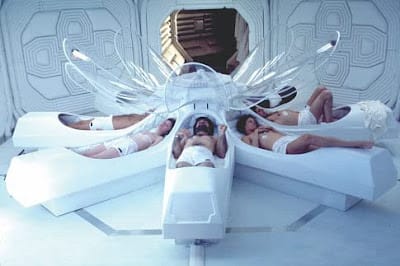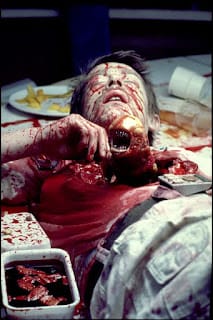
The narrative structure used for Alien contains many similarities to a typical slasher film, such as Halloween (Carpenter, 1978). “In narrative terms, it is little more than a science fiction slasher movie, in which an alien creature kills off the crew of a spaceship one by one until it is eventually killed by the film’s own final girl, Ellen Ripley.” (Grainge, Jancovich & Monteith, 2007, p. 439). These facts work in favour of Alien for an audience familiar with Halloween. Bruce Kawin poses a scenario in the introduction of his essay Children of the Light:
An audience’s familiarity with Halloween would enable them to form such connections with Alien, but it may not be a conscious one, leading to the uncanny familiarity felt when viewing. Scenes may feel familiar, because of the underlying connections in the plot structure, but may also be due to the portrayal of a strong female lead, which wasn’t as common at the time. Brigid Cherry discusses this: “Many respondents felt that the representation of a strong, intelligent and resilient female was a major change from the vast majority of female roles they had previously seen.” (Cherry, 2002, p. 171).


The fact that the crew are so far away from, and have lost communication with home/heimlich (the shuttle and by extension, the mothership) and the sense that something terrible is about to happen becomes unbearable. When Kane slips into the enclosure and nothing terrible happens, that build-up of tension is falsely released. Very soon and suddenly after, Kane is attacked by the facehugger. The tension was already released, making this even more startling for an audience, who have let their guard down too soon. The otherwise slow scene comes to an abrupt end, cutting to an exterior shot of the alien spaceship the moment after the facehugger attacks Kane, robbing the audience of knowing precisely what has happened until Ash (Ian Holm) is examining him in the medical bay later. This scene returns to the brightly lit and “safe” area of the Nostromo, thus enticing an audience back into a false sense of safety.

In contrast to the brightly lit scene at the dinner table, the first scene in which we see the Alien in its adult form is devoid of most colour in a poorly lit and closed off section of the ship. It is the complete opposite: The surfaces are dirty, water is pouring from the ceiling, and the chains are jangling. This scene is stretched out as much as it can be before it breaks. The persistent sound of the radar device beeping, the chains jangling, and water dripping are unnerving almost to the point of annoyance “evok[ing] fear and dread” (Freud, 2003, p. 123).


When the alien first bursts from Kane’s chest, it is symbolic of a toothed phallus, but later in the film when it has grown to its adult form, it better represents a succubus-like creature “devoid of any humanity, compassion or emotion [which] amplifies its ability to terrorize the characters and the audience alike.” (Frost, 2011, p. 93) and plays on that fear of the unknown.
This essay has discussed several ways Alien represents the Unheimlich. From the use of setting and visuals, long and drawn-out scenes and sudden false releases of tension, to the unexpected change in a character’s behaviour and representation of the womb. The uncanny is subtle in some areas, strong in others, but is well represented throughout.
- [Alien Film Poster]. (n.d.). Retrieved 14 January 2025, from https://www.imdb.com/title/tt0078748/mediaviewer/rm1173690368/
- [Ash is revealed to be an android]. (n.d.). Retrieved 14 January 2025, from https://www.imdb.com/title/tt0078748/mediaviewer/rm2304547329/
- Bordwell, D., Thompson, K., & Smith, J. (2017). Film Art (11th ed.). McGraw-Hill.
- Carpenter, J. (1974). Dark Star [Film]. Jack H. Harris Enterprises; University of Southern California (USC).
- Carpenter, J. (1978). Halloween [Film]. Compass International Pictures; Falcon International Pictures; Falcon International Productions.
- Cherry, B. (2002). Refusing to refuse to look. Female viewers of the horror film. In M. Jancovich (Ed.), Horror. The Film Reader. (pp. 169–178). Routledge.
- Creed, B. (2015). Horror and the Monstrous-Feminine: An Imaginary Abjection. In B. K. Grant (Ed.), The dread of difference: Gender and the horror film (pp. 37–67). University of Texas Press.
- Dickstein, M. (2004). The Aesthetics of Fright. In B. K. Grant & C. Sharret (Eds.), Planks of Reason. Essays on the horror film. (pp. 50–62). Scarecrow Press.
- Freud, S. (2003). The Uncanny. Penguin Group. (Original work published 1919).
- Frost, C. (2011). Alien. In L. Geraghty (Ed.), Directory of World Cinema. American Hollywood. (pp. 91–93). Intellect Ltd.
- Grainge, P., Jancovich, M., & Monteith, S. (2007). Film Histories. An introduction and reader. Edinburgh University Press.
- [Kane discovers the eggs]. (n.d.). Retrieved 14 January 2025, from https://www.imdb.com/title/tt0078748/mediaviewer/rm83135488/
- Kawin, B. (2020). Children of the Light. In B. K. Grant (Ed.), Film Genre Reader IV (3rd ed., pp. 360–381). University of Texas Press.
- Kubrick, S. (1968). 2001: A Space Odyssey [Film]. Metro-Goldwyn-Mayer (MGM); Stanley Kubrick Productions.
- [Lambert encounters the Alien]. (n.d.). Retrieved 14 January 2025, from https://www.imdb.com/title/tt0078748/mediaviewer/rm1514047232/
- Scott, R. (1979). Alien [Film]. Twentieth Century Fox; Brandywine Productions; Scott Free Productions.
- [The Alien breaks out of Kane’s chest]. (n.d.). Retrieved 14 January 2025, from https://www.imdb.com/title/tt0078748/mediaviewer/rm3407714304/
- [The crew of the Nostromo in their hybernation pods]. (n.d.). Retrieved 14 January 2025, from https://www.imdb.com/title/tt0078748/mediaviewer/rm3374159872/
APA7
Cable, J. (2025, Jan 14). How is the unheimlich represented in Alien (1979)?. JCableMedia.com. https://www.jcablemedia.com/2025/01/14/how-is-the-unheimlich-represented-in-alien-1979/.
Chicago
Cable, John. “How is the unheimlich represented in Alien (1979)?.” JCableMedia.com. January 14, 2025. https://www.jcablemedia.com/2025/01/14/how-is-the-unheimlich-represented-in-alien-1979/.
Harvard
Cable, J. (2025). How is the unheimlich represented in Alien (1979)?. Available at: https://www.jcablemedia.com/2025/01/14/how-is-the-unheimlich-represented-in-alien-1979/ (Accessed: 07 April 2025).